Edition #1
Introducing the New England Agroforester

The New England Agroforester is the ADAPT Project's quarterly newsletter, providing timely and useful info on regional agroforestry projects, training opportunities, research activities, events, job postings, funding announcements, and more. Through this newsletter, we hope you’ll learn about agroforestry developments in New England and get involved in your own community.
Adaptive Agroforestry Principles & Teaching-New England (ADAPT), a USDA-funded project based at University of New Hampshire, with partners Dartmouth College and Yale University and in collaboration with cooperators, consultants, and service providers throughout the Northeast, explores agroforestry's potential as a climate-smart and sustainable strategy for expanding agricultural production in New England.
The New England Agroforester is part of ADAPT’s commitment to communicating relevant developments and resources to a wider audience. Through integrated research, education, and extension, ADAPT is developing a network of demonstration sites, creating the New England Agroforestry Training Program (NEAT) at UNH Extension, and providing agroforestry educational opportunities. Our newsletter Editorial Advisory Board provides expert guidance and support, contributing to strategic direction, content quality, and impact among the diverse agroforestry community.
Check out our story in UNH Today, explore the Agroforestry Transition Hub at Dartmouth College, and learn what a Yale-led team of scientists have discovered about the climate and economic benefits of agriculture in forests.
What you’ll find in The New England Agroforester:
Feature Stories are in-depth articles with photos showcasing current agroforestry projects or practices, highlighting the diversity and creativity within agroforestry practices. These could be case studies, descriptions of farm/forest management strategies, policy developments affecting agroforestry, or organizations doing interesting work in the field.
Technical Assistance & Peer Networking provides practical tools, guides, and cooperative opportunities to help practitioners implement and improve their agroforestry systems. This section connects community members with technical resources and networking opportunities to share knowledge, solve challenges, and collaborate on projects.
Practitioner Profilesfeature in-depth interviews or stories on farmers, foresters, land managers, and others who are implementing agroforestry systems, describing their ambitions, challenges, and innovations. These profiles highlight personal stories behind successful operations to inspire and inform the growth of agroforestry in New England.
The Research Grove features summaries of recent studies and findings, proposed research applications, researcher profiles, and invitations to participate in current research projects.
The Learning Landscape offers educational opportunities such as classes, professional development, publications, guides, webinars, and surveys to advance agroforestry knowledge and skills. This includes both formal and informal learning pathways to understanding and implementing sustainable tree-crop systems.
Seeding Success: Funding and Finance Opportunities includes grants and financial resources with application information to help practitioners, researchers, and organizations secure capital for agroforestry projects. This section provides detailed funding announcements, eligibility requirements, and deadlines to support the financial growth needed to establish, expand, or research agroforestry systems.
Events Calendar features upcoming workshops, field days, conferences, and webinars that bring together the agroforestry community for learning and networking. Dates and details for both virtual and in-person events where practitioners can gain practical skills, share experiences, and connect with fellow professionals in the field.
Classifieds are where to share and find equipment and materials, land and property, professional services, job opportunities, member/subscriber connections, etc.
Photo-Synthesis: Reader-Submitted Images features photos, maps, drawings, and visuals from the agroforestry community, showcasing tree-crop systems, wildlife, seasonal changes on working landscapes, and other subjects.
Do you want to see a policy section in this newsletter? An agroforestry policy section may include regional and statewide legislative updates, market perspectives on relevant regulations, topics of land tenure and equity, policies around research and education, news on changes or terminations of existing programs, and opportunities to advocate. What are your interests and questions concerning policy as an agroforestry practitioner, researcher, consultant, educator, or concerned community member? Give us your thoughts!
Help grow our community of readers
Do you know someone involved in forest, farm, conservation, or food systems who would be interested in The New England Agroforester? We are growing our community of readers and invite you to send them this link to the subscription form.
From Forest to Pasture: Exploring Climate-Smart Silvopasture at UNH
The gentle rumble of a tractor echoed across the University of New Hampshire research plot as our field day group gathered to witness silvopasture science in action. What had once been dense forest was now being transformed through the ADAPT Project—a five-year USDA-funded collaboration between UNH, Dartmouth, and Yale aimed at developing climate-smart strategies for expanding New England agricultural production.
Aaron, one of ADAPT’s Project Managers, led our group across the experimental landscape where trees, livestock, and pasture grasses are being integrated in carefully planned systems.
Two Paths to Silvopasture
Silvopasture—the integration of trees, livestock and pasture—can be established through two main approaches, both of which are being tested at the UNH site. Aaron took us to the "silvopasture by subtraction" plot, where the process starts with forested land, and involves selectively removing trees and establishing forages to create productive grazing areas while maintaining beneficial tree cover.
The preparation work was evident everywhere. Lime had been spread to address the soil's challenging pH of about 4—extremely acidic and nutrient-poor conditions that make this site particularly valuable for research. Fresh manure was being applied from recent barn cleanings, providing precious nutrients. The forestry mulcher, despite struggling with the uneven terrain, had processed remaining slash into wood chips of various sizes, distributing natural mulch throughout the area.
Working with Natural Systems
When the team encountered a persistently wet middle section, rather than fight the hydrology, they modified the research layout, creating silvopasture on both sides of the wet area, with completely treeless pasture beyond. This arrangement provides data across one hectare each of silvopasture, treeless pasture, and reference forest, enabling the researchers to compare land uses. Laneways flanked both sides of the central wet area, with gates allowing dairy cows to move efficiently between milking in the barns and the fresh paddocks in their rotational grazing system, the kind of practical consideration that researchers must have when operating on a working farm.
The infrastructure serves both research and practical farming needs. A complete set of equipment—manure spreader, seed spreader, forestry mulcher, and disc harrow—supports the work. The site is established with a team approach in which UNH’s Land Use Coordinator, Steve Eisenhaure, and UNH’s Burley-Demeritt farm managers, Jason Scruton and Isagani Kimball, cleared and prepared the site. The ADAPT Project’s Silvopasture Science Team and Aaron as the project manager provide technical direction and document results.
The silvopasture establishment process is emerging into a successful formula: Thin the forest, remove brush, scarify the soil, then seed in the early fall to give forage grasses a competitive advantage before winter. However, there is still much to learn before protocols for establishing silvopastures by subtraction in New England are standardized. Researchers are examining how establishment practices vary across the region, and how practices such as adding lime and manure can help establish silvopastures in poor soils like these.
Tradeoffs in infrastructure are also an important subject of research. While fencing materials remain relatively affordable, labor costs for post installation drive project expenses. The right equipment makes a difference; the fencing contractor they hired installed a fence post through a stone wall in just minutes, a capacity that impresses the ADAPT team. UNH was fortunate to have a forestry mulcher on-site to assist in establishing the research site.
The goal is to “move at the speed of possibility," Aaron explained, capturing the balance between research rigor and establishing a system that will function on a working farm.
Ecosystem Services in Action
Operators recognize that well-managed livestock grazing in a silvopasture can simultaneously provide the agricultural benefits of food production and the ecosystem services associated with forests. Agriculture contributes economic livelihoods and regional food for healthy communities; forests provide clean water, clean air, building materials, wildlife habitat, carbon storage and sequestration, and more. The field day highlighted the ADAPT Project’s ongoing silvopasture research as both scientifically rigorous and practically grounded, addressing immediate challenges while building knowledge and exploring the benefits and tradeoffs provided by silvopastures and other forms of agroforestry in New England.
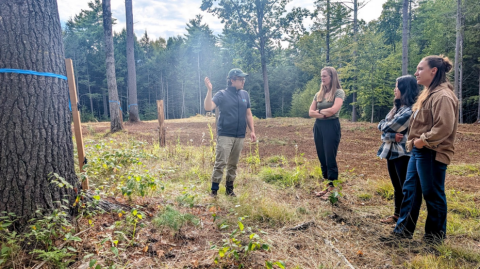
Project Manager Aaron Guman (UNH), Graduate Student Krystal Bagnaschi and post doc Martha Torstenson (Dartmouth), and Researcher Theresa Ong (Dartmouth) tour the experimental plots at UNH’s Organic Dairy Research Farm, operated by the NH Agricultural Experiment Station and College of Life Sciences and Agriculture in Lee, NH
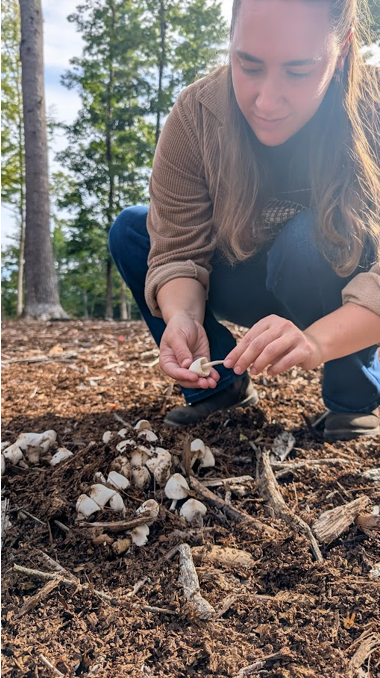
Graduate Student Krystal Bagnaschi (Dartmouth) examines fungi that cropped up in an experimental agroforestry plot at the UNH Organic Dairy Research Farm.

Application of cow manure in an experimental plot at the UNH Organic Dairy Research Farm during the ADAPT agroforestry field day and Fall Gathering on September 17.
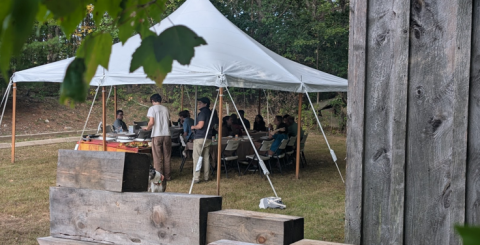
After the field day, team members joined up at the UNH Sawmill for the ADAPT Fall Gathering. Serving the UNH community since 1968, the UNH sawmill provides lumber that is sustainably harvested from university land by Thompson School of Applied Science students as part of their hands-on studies in the Forest Technology program.
Technical Assistance & Peer Networking
Working Lands for Wildlife

Working Lands for Wildlife (WLFW)’s “Tools, Maps, and Apps” section of its website provides digital resources valuable for agroforestry practitioners and consultants working on landscape-scale conservation projects.
The centerpiece is the Landscape Explorer, an interactive mapping application that allows users to compare historical imagery from the 1950s with modern imagery (2014-2023) across Western landscapes from the Great Plains to the Pacific Coast. This temporal analysis capability is particularly useful for agroforestry practitioners to assess landscape changes and identify optimal sites for tree-based interventions.
The Landscape Explorer highlights three key landscape changes relevant to agroforestry planning: woody plant encroachment by species like eastern redcedar and pinyon-juniper into native rangelands, cropland expansion impacting wildlife habitat and grazing lands, and urban sprawl affecting open spaces. Understanding these patterns helps practitioners identify where agroforestry systems could provide ecological and economic benefits.
The Rangeland Analysis Platform offers maps, calculators, and charts that help identify intact landscapes, assess threats, and track productivity changes over time. These tools can quantify forage losses from tree encroachment, identify optimal locations for treatments to control invasive species, assess how water sources perform during drought conditions, and evaluate wildfire probability based on grass production patterns.
These data-driven tools enable agroforestry practitioners to make evidence-based decisions about where to implement tree-based systems, how to integrate them with existing land uses, and how to design interventions that address specific landscape challenges while maintaining agricultural productivity and wildlife habitat.
CRWFA Farmer Forum
Connecticut River Watershed Farmers Alliance (CRWFA) offers a Farmers Forum for members to learn more about farming and conservation practices directly from other members. For more information: CRWFA.info@gmail.com or (802) 369-3167.
The Research Grove
Planting the Future: Yale’s Agroforestry Experiment in a Seed Tree System
Contributor: Bernard Nyanzu, MF 2024, ADAPT Postgraduate Fellow, Yale Forest
What if the same forest that provides timber could also grow fresh food? That's the idea behind Yale's latest agroforestry project, where food-producing trees and shrubs are planted alongside traditional timber management systems. The goal is simple but powerful: combine food production with healthy, productive forests that continue to provide essential ecosystem services.
This experiment, led by Professors Mark Ashton and Joe Orefice with three Yale School of the Environment master's students—Cayce Morrison '26 MEM, Gabriela D'Orazio '26 MFS, and De-Graft Acquah '26 MF—assisting in coordinating the design and implementation, is taking place in a stand at Yale-Myers Forest where a shelterwood harvest was recently completed. In a shelterwood system, foresters harvest trees in stages, leaving some residual trees to provide shade and seed for regeneration. The result is large canopy openings dotted with standing trees—perfect conditions for testing how agroforestry crops respond to different light levels.
To understand how light shapes growth, we divided the planting area into three distinct zones: North Zone (the shaded north side of residual trees), South Zone (the sunnier south side of residual trees), and Open Zone (areas at least 10 meters away from residual trees). This setup allows us to test how food crops grow under varying degrees of shade and competition from nearby trees. Within these zones, we planted groupings of five agroforestry crops, each chosen to represent a spectrum from shade-tolerant to shade-intolerant species: Chinese Chestnut, Elderberry, Black Walnut, Pawpaw, and Persimmon. Across the site, we established 20 replications in each light zone, with five plants per zone. In total, that's 300 trees and shrubs, carefully arranged to show how light and location influence survival and growth.
Looking ahead, by monitoring these plantings over time, we hope to learn how agroforestry crops can be integrated into working forests in New England. For landowners, this approach offers the potential to harvest both timber and food from the same land. For researchers and students, it provides a living laboratory to study forest dynamics, light competition, and climate adaptation strategies.
ADAPT Project Manager Finds Inspiration and Practical Insights at Agroforestry Conference
When Aaron Guman, Project Manager with the ADAPT team at the University of New Hampshire, returned from the 2025 North American Agroforestry Conference in Missouri, he brought back more than research findings and networking contacts. He was energized by a community of practitioners who share his passion for integrating trees with agriculture, and equipped with examples of how these systems can succeed over the long term.
Global Conversations Reveal Universal Challenges
For Aaron, the conference was a valuable opportunity to compare notes with practitioners working in vastly different contexts. He describes an illuminating conversation with a Scottish researcher who sketched out a Venn diagram comparing agroforestry development across the UK, EU, and United States.
"What struck me was how, despite completely different political systems and funding structures, we're all facing remarkably similar barriers," Guman explains. "Equitable land access, research funding gaps, and the need for more demonstration sites are challenges that transcend borders."
The conversation also revealed interesting contrasts. Guman was intrigued to learn about England's remnants of royal land ownership, where enormous percentages of land remain under royal family control. "It's such a stark difference from American land ownership patterns," he notes. "These kinds of exchanges really broaden your perspective on what's possible and what's challenging about implementing agroforestry in different contexts."
Seeing Mature Systems in Action
Coming from New England, where mature agroforestry demonstration sites are relatively scarce, Guman found the field tours especially valuable. The Missouri research farm showcased long-standing experiments that provided concrete evidence of system viability over decades.
"A highlight was this chestnut and winter wheat alley cropping system with an accompanying processing facility that's been operating successfully for twenty years," Guman shared with enthusiasm. "For those of us working to build economic arguments for agroforestry adoption, seeing that kind of proven track record was encouraging."
The tours weren't limited to established systems. Guman also visited newer operations featuring sheep and hog silvopasture systems incorporating tree fodder. "What I appreciated was seeing that farms at any stage of development, whether established twenty years ago or just getting started, all offer valuable learning opportunities," he observes.
Research That Spans Every Angle
The breadth of conference sessions, covering everything from economics and medicinal compounds to wildlife habitat, ecosystem services, soil health, and microbial communities, impressed Aaron. He says it reinforced how interdisciplinary the field is and how many different benefits these systems can provide.
Guman heard themes in the feedback sessions that resonated with his own professional experience. "Researchers kept emphasizing what we all know we need: more demonstration sites showing systems that work physically, ecologically, and economically," he explains. There’s a widespread hunger for practical data like establishment costs, realistic timelines, and specific guidance for farmers and foresters who want to try this.
The policy discussions particularly struck him because they emphasized that it’s not only about increasing the amount of funding available, but providing structural support that matches how farmers actually operate. Aaron saw that other attendees appreciated the practical thinking about implementation barriers.
Acknowledging Indigenous Wisdom
Aaron appreciated the conference's recognition of agroforestry's Indigenous roots. Several sessions acknowledged that current research represents a rediscovery of ancient practices embedded in cultures worldwide. "It made me reflect on how our modern work is really about rediscovering methods of relating to the land that have been ignored or actively suppressed," Aaron shared. "That awareness brings humility in what we're trying to accomplish."
He was also excited by the conference's innovative format, which incorporated participatory sessions with body movement and art alongside traditional presentations. "The creative approaches opened up different ways of sharing knowledge and building community that complemented the scientific content beautifully."
Building Professional Community
"Academic veterans with PhDs and decades of experience approached early-career people like myself with genuine curiosity about our work," he recalls. "It created opportunities for meaningful exchange. The community felt supportive rather than competitive."
The conference food featured local agroforestry ingredients including walnuts, persimmons, and elderberries, while a student-organized bake sale supporting the campus agroforestry club added to the community atmosphere.
Welcoming Newcomers
A key takeaway for Aaron was that "this is the conference for North American agroforestry." Anyone in the field should come ready to absorb an incredible amount of information from passionate, knowledgeable practitioners. The combination of cutting-edge research, practical applications, and genuine community makes it invaluable.
The experience also reinforced Aaron’s belief about the field's future: that agroforestry's success depends on continued collaboration across disciplines, geographies, and experience levels. The conference reminded him that “we're all working toward the same goal, even from different angles and in different places.”
As he settles back into his work with the ADAPT team, Guman carries new research findings, professional contacts, and renewed confidence in the agroforestry community. "Sometimes you need that reminder that you're part of something bigger," he says.
For more about the 2025 NAA Conference including a great photo gallery, check out the Center for Agroforestry’s latest newsletter story, “North American Agroforestry Conference returns to Missouri roots: Sharing research and practice to inform the future of perennial landscapes.”
Yale Forest Research Opportunities
The Yale Forests are living laboratory for teaching, management, and research. The Forests span over 10,000 acres of forestland across three New England states. The Yale Forests welcome research applications from faculty, students, and research affiliates from across Yale and from other universities and organizations. Prospective researchers should contact Laura Green, Research & Extension Forester, at laura.green@yale.edu for additional information and submit an application. For more information visit: https://forests.yale.edu/
Practitioner Profile
From Military Service to Multi-Strata Systems: Jon Turner's Wild Roots Farm
Jon Turner didn't grow up on a farm, but the pull of working with the soil found him. After three deployments in Iraq, the veteran found himself struggling with the transition back to civilian life until a friend's garden changed everything. "As soon as I put my hands in the soil, things just clicked," Turner recalls of that pivotal moment in 2009 that would reshape his entire trajectory.
Today, Turner operates Wild Roots Farm in Bristol, Vermont, just eight miles from Middlebury College. What began as a single garden has evolved over fifteen years into a sophisticated agroforestry operation that integrates livestock, perennial crops, and forest gardening principles to build soil biology and nutrient-dense yields.
Building Systems Through Integration
Turner's land hosts goats, managed for six years through rotational grazing, in silvopasture systems supporting gooseberries, aronia berries, black currants, hybrid chestnuts, and oaks that serve as windbreaks and riparian buffers. His approach exemplifies the multi-layered thinking that defines successful agroforestry. Ducks and chickens contribute to the integrated system, while he recently processed his last pig of the season—part of a livestock operation he's developed over four years, processing about two dozen pigs.
The farm operates on ecological principles that Turner embraced from his earliest gardening days. He's transitioned from growing mushrooms on logs to using those decomposing logs in garden beds to build soil biology. Every element serves multiple functions: animals provide meat while managing pastures, trees offer protection while producing nuts and berries, and integrated systems work together to improve soil health and farm resilience.
Teaching Through Demonstration
Turner's commitment to education runs as deep as his farming practice. For ten semesters before COVID, he hosted UVM Rubenstein School seniors for their Natural Resources capstone course, and he continues to work with students from Middlebury College. Participants span from K-12 students to college, covering everything from developing multi-strata forest garden systems to survival skills.
What sets Turner's educational approach apart is his integration of the entire food cycle. Processing days become community workshops where participants—including vegans interested in vegetable production—learn the complete process from dispatch through breakdown. "I enjoy working with college students who are contemplating what the food system can and should look like after graduation," Turner explains. These sessions often culminate in shared meals featuring the products of their work, with local bakers creating dishes like pâté from fresh liver.
Navigating Support Systems
Turner's experience accessing federal conservation programs offers valuable insights for other veterans and beginning farmers. He's utilized both NRCS EQUIP and Conservation Stewardship Program funding to support his agroforestry development. His willingness to share navigation strategies for these programs, particularly for the veteran population, reflects his broader commitment to supporting others in sustainable agriculture transitions.
Turner worked for several years with the Farm Veteran Coalition, helping other service members transition into agriculture through an ecological lens. This experience informs his understanding of the challenges for beginning farmers without agricultural backgrounds.
Fall Forward
Turner is preparing for a massive tree planting this fall including persimmons, honey locust, hybrid chestnuts, and hazelnuts—species chosen for their multiple functions in his integrated system. After ten years of experimentation, he's candid about lessons learned: "Some things we've done right, some we would do differently," he reflects, embodying the adaptive management approach essential to successful agroforestry.
Turner's story exemplifies two principles essential to successful agroforestry: integration and community. His farm demonstrates that true sustainability emerges from understanding how livestock, trees, crops, and people can work together as interconnected systems. Equally important, his commitment to sharing knowledge— teaching students, mentoring fellow veterans, opening his processing days to neighbors—shows how agroforestry thrives when practitioners build community around their work. In Turner's hands, farming becomes both a personal practice and a collective endeavor, creating resilience in soil and ecosystems as well as the human networks that sustain them.
Jon continues to share insights from his decade-plus journey in ecological agriculture and agroforestry implementation. For those interested in following his work, Wild Roots Farm can be found on Instagram (@wildrootsfarmvt) and through his educational website, www.wildrootsfarmvermont.com/.
The Learning Landscape

USDA Northeast Climate Hub: Science-based, region-specific information and technologies to enable climate-informed decision-making
Those interested in Northeast Climate Hub offerings can view this presentation by Lindsey Rustad, PhD, Director, USDA Northeast Climate Hub that includes (1) an overview of the USDA Climate Hubs, (2) a focus on the Northeast Climate Hub, and (3) Northeast impacts, adaptation and mitigation. The Northeast Climate Hub also offers a YouTube channel that includes "Weathering the Change," an eight-part educational series about climate change, how it is affecting agriculture in the US, and how producers can be resilient to those changes. For more information visit the USDA Northeast Climate Hub.
Agroforestry Transition Hub
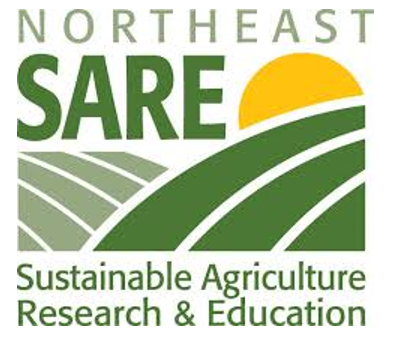
Through a SARE grant, ADAPT Project lead Theresa Ong, Ph.D. and her team at Dartmouth College have developed the Agroforestry Transition Hub for education and on-farm research to advance agroforestry for climate resilience for Northeast farmers. This set of education and technical assistance resources (including the Agroforestry zine, Benefits of Trees Zines, and Agroforestry Transition Hub video) range from crop production, farm business management, natural resources and environment, pest management, soil management, and sustainable communities. The project provides farmers with seedlings and support to bolster on-farm climate resilience, which is measured by soil health indicators. The target is 200 farmers reached through peer-peer networking and measurable improvements in soil water infiltration for farms participating in the training program. For more information, visit the Agroforestry Transition Hub’s SARE page.
Wild Seed Project: Native and climate-resilient plant resources for Northeast landscapes
Wild Seed Project in North Yarmouth, Maine equips community members with the resources they need to collectively restore native plants that expand wildlife habitat, support biodiversity, and build climate resilience. Recent newsletter highlights include bayberry, pagoda dogwood, black elderberry, silky dogwood, and shrubby St. John's Wort—native species well-suited to Northeast landscapes. Wild Seed Project grows their plants from seed, and proceeds from plant sales help fund their conservation initiatives. The organization maintains a comprehensive "Learn" section on their website with a resource library that includes publications, instructional videos, and the excellent Wild Seed magazine. Their educational materials cover topics such as gardening with native plants for biodiversity, developing climate-resilient plantings, and selecting appropriate native groundcovers, shrubs, and trees for Northeast regions. For more information, visit the Wild Seed Project.
Cornell Small Farms Program: Live instruction begins this week
The Cornell Small Farms Program connects farmers with extension educators, agricultural service providers, and experienced farm mentors. The Program pairs live instruction and Q&A with self-paced work that can be done around chores, and farmers keep the materials to revisit as their farm evolves. The first block of live-instructed courses begins this week (September 22). For more information, visit Cornell Small Farms Program.
Events Calendar
ADAPT Agroforestry Training at UNH
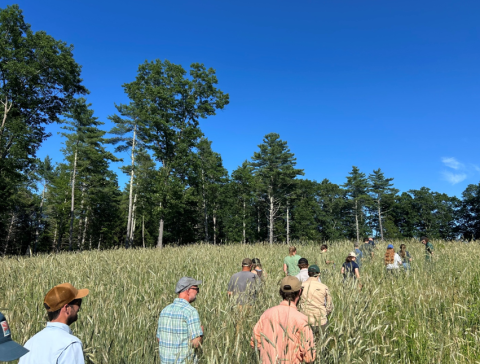
The ADAPT team at UNH is developing agroforestry training opportunities for farmers, land managers, and professionals who work with the farming community. We encourage folks to fill out this very short questionnaire to be notified when trainings and workshops are scheduled. For more information contact: Steven S. Roberge, Extension Forestry Specialist & Professor, NH Licensed Forester #421, UNH Cooperative Extension, by email: steven.roberge@unh.edu or phone: (603) 862-4861 office, (603) 674-7095 cell.
Fall Offerings at Wild Seed Project
See wildseedproject.net/events for full details and links to sign up. Note: Outdoor events are subject to change due to weather.
Saturday, October 4: Fall Planting Workshop with Wolfe's Neck Environmental Center
Tuesday, October 14: Member Q & A – online
Thursday, October 23: Four Season Walk with Friends of Fort Williams
Tuesday, October 28: Four Season Walk with Kennebec Estuary Land Trust
Friday, November 7: Seed Sowing Workshop at Viles Arboretum
Thursday, November 13: Member Q & A – online
Saturday, November 15: Seed Sowing Workshop at Portland Public Library Burbank Branch
Thursday, December 4: Make Life Easier with Native Plants – online
Saturday, December 6: Seed Sowing Workshop at Wild Seed Project’s Native Seed Center
Tuesday, December 9: Member Q & A – online

Forest Farming with Botanicals at UVM Center for Sustainable Agriculture
Tuesday, October 7 and Wednesday, October 8. Learn how to successfully establish a production-scale forest botanical polyculture. Includes a ginseng planting immersive led by Kai Thomas of Soul Fire Farm and Liang Cheng, Quebecois ginseng grower, Young Roots Farm. Each participant will leave with a small pack of ginseng seeds and planting instructions. Forest Farming workshops are a collaboration among the University of Vermont, Smokey House Center, NOFA-VT, VT Department of Forests, Parks, and Recreation, Northeast Forest Farmers Coalition, and USDA Northeast Climate Hub. This workshop earns one RAP Agricultural Water Quality education credit. For more information, visit the UVM Center for Sustainable Agriculture.
Annual Harvest Festival at Yale-Myers Forest
Saturday, September 27, 2025 at Yale-Myers Forest Camp in Eastford, Connecticut. For more information, visit the Yale-Myers Forest.

Highstead’s 2025 Regional Conservation Partnership Network Gathering
Thursday, November 6 at UMass Amherst. The Regional Conservation Partnership (RCP) Network Gatheringv is an inclusive forum for people to meet and share stories about collaborative landscape conservation. Sessions include “Centering Reciprocity in Land Trust and Indigenous Community Relationships” and “Coordinating Across Geographies, Scales, Strategies, and Sectors to Improve Conservation Outcomes for All.” Featuring 16 dynamic sessions led by nearly 50 speakers, plus a special closing plenary, this FREE event offers something for everyone. Visit the RCP registration page for the agenda, session summaries, and speaker bios. The registration deadline is Thursday, October 30, 2025. For more information, email: RCPInfo@highstead.net.

Save-the-Date: New England Society of American Foresters (NESAF) Annual Meeting 2026
March 18-20, 2026 in South Portland, Maine. For more information, visit NESAF.
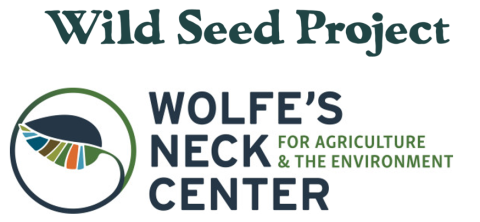
Seed Fall Planting Workshop
Saturday, October 4 in Freeport, Maine. Want to learn how to plant a native garden from scratch and get your hands dirty while you're at it? Wild Seed Project and Wolfe's Neck are teaming up to offer a hands-on fall planting workshop. For more information and to register, visit Wild Seed Project.
Funding & Finance Opportunities
The New England Society of American Foresters (NESAF) invites ideas for projects or programs in need of financial support through the NESAF Grants Program. Grants can be used to educate the public about professional forestry and to promote the role of foresters in forest resource management. Applications are considered once per year and are due by December 1 (prior to the December meeting of the NESAF Executive Committee). For more information, visit NESAF.

Vermont Agency for Agriculture Food and Markets lists funding opportunities including grants, loans, and financial assistance. Anyone needing help navigating the Agency’s funding opportunities can also contact the Agriculture Resource Navigator at 802-261-7395 or email Jennifer.Porter@vermont.gov.

American Farmland Trust (AFT) lists grants on their website including Brighter Future Fund’s New England Regenerative Livestock Farming Grants program, which provides up to $10,000 in funds for livestock farmers in select counties in Vermont, New Hampshire, Massachusetts and Connecticut to adopt regenerative agriculture practices. Readers can also sign up to receive updates about future grant cycles. AFT can also help farmers find capital, prepare for credit, access grants and incentives through Farm Credit East, and retain and improve rented land. Their page includes resources for landowners, farmers and beginning farmers, policy makers and professionals, planners and local officials. For more information, visit American Farmland Trust.
Classifieds
Free Trees for Livestock Farmers
The White River Natural Resources Conservation District (NRCD) has trees available for livestock farms throughout the Connecticut River Watershed Farmers Alliance (CRWFA) area, not just in the White River district. Tree species include yellow bud hickory, mulberry, chestnut, and honey locust, all useful as food or fiber, for pollinators, and to support biodiversity in general. View species profiles here. Get 20-50 trees per farm. Fall 2025 Orders must be placed by October 1. For more information, email WhiteRiverNRCD@gmail.com or call (802) 369-3167.
Agroforestry Employment
Research Assistant Professor in Agroforestry at University of New Hampshire:
A Research Assistant Professor in Agroforestry position is still open and has been re-posted on UNH’s new job platform. The ADAPT team appreciates your help in spreading the word to anyone who may be interested or knows of potentially interested candidates.
New England Society of American Foresters (NESAF) provides job listings for forest professionals and organizations. For more information, visit NESAF.
Graduate Student and Postgraduate Employment at Yale Forests:
Yale Forests hires in the fall season for Forest Manager and Assistant Manager and Agroforestry Research Postgraduate Associate positions. For more information visit Yale Forests.
Forest Technician/Forester at Upper Valley Forest Management:
Upper Valley Forest Management (UVFM) in Thetford Center, Vermont is hiring a Forest Technician / Forester. For full job description and application details, visit UVFM or contact Donn Downey, donn@uppervalleyforest.com.
New England Society of American Foresters’ Job Listings:
NESAF provides job listings for forest professionals and organizations. Job listings are posted for 45 days. Use NESAF’s Job Listing Form to submit your listing.
Executive Director at Wild Seed Project
Wild Seed Project is hiring an Executive Director. While interviews are currently underway, applications will continue to be accepted until the position is filled. Apply by sending a cover letter and resume to edsearch@wildseedproject.net.
Be an Editorial Advisor for The New England Agroforester
The New England Agroforester welcomes newcomers to the Editorial Advisory Board! We also offer our invitation and guidelines for submissions and are happy to work with you to create stories, articles, listings, profiles, and news you’d like to share. For more info: Contact Jess Gerrior, Communications Specialist/Newsletter Editor, by emailing agroforestry@unh.edu.
Help us grow this section! Send your images to: agroforestry@unh.edu. Images will only be shared with author’s permission.
UNH Land, Water, and Life Acknowledgement
As we all journey on the trail of life, we wish to acknowledge the spiritual and physical connection the Pennacook, Abenaki, and Wabanaki Peoples have maintained to N’dakinna (homeland) and the aki (land), nebi (water), olakwika (flora), and awaasak (fauna) which the University of New Hampshire community is honored to steward today. We also acknowledge the hardships they continue to endure after the loss of unceded homelands and champion the university’s responsibility to foster relationships and opportunities that strengthen the well-being of the Indigenous People who carry forward the traditions of their ancestors.
ADAPT TEAM:
PRINCIPAL INVESTIGATORS:
Heidi Asbjornsen, Ph.D. , University of New Hampshire
Mark S. Ashton, Ph.D. , Yale University
Ranjit Bawa, Ph.D., University of New Hampshire
Alix Contosta, Ph.D., University of New Hampshire
Kate Guerdat, Ed.D., University of New Hampshire
Theresa W. Ong, Ph.D., University of New Hampshire
Steven Roberge, University of New Hampshire
PROJECT MANAGERS:
Aaron Guman, University of New Hampshire
Ryan Smith, University of New Hampshire
COMMUNICATIONS SPECIALIST:
UNIVERSITY RESEARCHERS:
Analena Bruce, Ph.D. (University of New Hampshire




